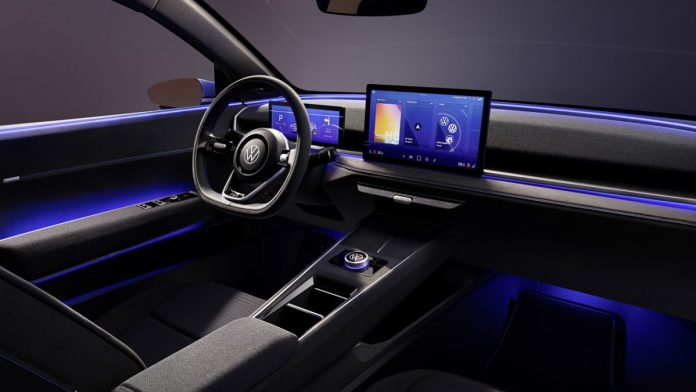Buttons are a great invention. Press once, on. Press again, off. The same goes for rocker switches and dials. A small movement and the windscreen wipers come on or the music gets quieter. The concept has been tried and tested for decades and is made for cars: You don’t even have to look to control the light or volume.
This realization seems to be gradually arriving at VW. You have “definitely done a lot of damage,” said brand boss Thomas Schäfer of the British magazine car. “We’ve had frustrated customers who shouldn’t be frustrated.” There’s a reason for the frustration that’s literally obvious: VW has shifted more and more functions from buttons to touchscreens.
In the new Tiguan, a screen continues to dominate the dashboard, but a large, round button returns to the center console. This should allow you to control driving modes and volume, for example. According to Schäfer, a huge team racked its brains for a long time to come up with a coherent concept and created Excel spreadsheets the size of an entire room. The unsurprising result: touchscreens are sleek and modern, but some functions belong on buttons and switches.
Touchscreens are just distracting
Anyone who has ever sat behind the wheel of a car might ask themselves: why only now? There is a good reason why cell phones are banned while driving – but a gigantic tablet with touch controls should be fine? In fact, some courts see it differently. A Tesla driver had to give up his driver’s license for a month because he went off the road while trying to adjust the interval of his windshield wipers. At Tesla, this is not possible on the steering wheel, but only via the touchscreen. The Karlsruhe Higher Regional Court found that this distracted the driver and that the “built-in touch screen” should be evaluated in the same way as a mobile phone.
The Tesla driver who had an accident and was convicted shows that the best way to focus your attention behind the wheel is on a particularly large, high-resolution screen. It’s called the windshield. Instead, many drivers press and swipe around on a second screen that shows a lot but not the surroundings. For years, studies have come to the conclusion that complex infotainment systems can distract and contribute to accidents.
Both the ADAC and the Swedish car magazine Vi Bilägare compared operating concepts with touch screens and buttons. Among the Swedish testers, a Volvo V70 from 2005 won by a wide margin – without a touchscreen. The ADAC punishes the Tesla Model 3 with last place: “The lack of separate buttons and levers for the headlights/rear fog lights and windscreen wipers leads to long operating times and thus dangerous distraction times.”
Customers want buttons back
Most automakers are sticking to the tablet-on-wheels concept. Led by Tesla, they focused on ever larger displays. It’s convenient and cheap for corporations to overload touchscreens. Hardware and software designers can work independently and do not need to coordinate. Functions can be reprogrammed and upgraded after delivery.
In the end, however, there must be people who buy the car – and at least at VW, their wish was clear. As early as last year, brand boss Schäfer wrote on Linkedin that we wanted to focus on “new simplicity in the operation of our cars”. That’s why you’re bringing back the buttons on the steering wheel, for example, which VW customers want. Some things were obviously better in the past.



